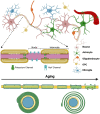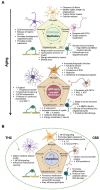Enhancing axonal myelination in seniors: A review exploring the potential impact cannabis has on myelination in the aged brain
- PMID: 37032821
- PMCID: PMC10073480
- DOI: 10.3389/fnagi.2023.1119552
Enhancing axonal myelination in seniors: A review exploring the potential impact cannabis has on myelination in the aged brain
Abstract
Consumption of cannabis is on the rise as public opinion trends toward acceptance and its consequent legalization. Specifically, the senior population is one of the demographics increasing their use of cannabis the fastest, but research aimed at understanding cannabis' impact on the aged brain is still scarce. Aging is characterized by many brain changes that slowly alter cognitive ability. One process that is greatly impacted during aging is axonal myelination. The slow degradation and loss of myelin (i.e., demyelination) in the brain with age has been shown to associate with cognitive decline and, furthermore, is a common characteristic of numerous neurological diseases experienced in aging. It is currently not known what causes this age-dependent degradation, but it is likely due to numerous confounding factors (i.e., heightened inflammation, reduced blood flow, cellular senescence) that impact the many cells responsible for maintaining overall homeostasis and myelin integrity. Importantly, animal studies using non-human primates and rodents have also revealed demyelination with age, providing a reliable model for researchers to try and understand the cellular mechanisms at play. In rodents, cannabis was recently shown to modulate the myelination process. Furthermore, studies looking at the direct modulatory impact cannabis has on microglia, astrocytes and oligodendrocyte lineage cells hint at potential mechanisms to prevent some of the more damaging activities performed by these cells that contribute to demyelination in aging. However, research focusing on how cannabis impacts myelination in the aged brain is lacking. Therefore, this review will explore the evidence thus far accumulated to show how cannabis impacts myelination and will extrapolate what this knowledge may mean for the aged brain.
Keywords: aged brain; astrocyte; cannabis; microglia; myelin repair; myelination; oligodendrocyte; oligodendrocyte progenitor cell.
Copyright © 2023 Murray, Vecchiarelli and Tremblay.
Conflict of interest statement
The authors declare that the research was conducted in the absence of any commercial or financial relationships that could be construed as a potential conflict of interest.
Figures


Similar articles
-
Oligodendrocyte, Astrocyte, and Microglia Crosstalk in Myelin Development, Damage, and Repair.Front Cell Dev Biol. 2016 Jun 28;4:71. doi: 10.3389/fcell.2016.00071. eCollection 2016. Front Cell Dev Biol. 2016. PMID: 27551677 Free PMC article. Review.
-
Deletion of Voltage-Gated Calcium Channels in Astrocytes during Demyelination Reduces Brain Inflammation and Promotes Myelin Regeneration in Mice.J Neurosci. 2020 Apr 22;40(17):3332-3347. doi: 10.1523/JNEUROSCI.1644-19.2020. Epub 2020 Mar 13. J Neurosci. 2020. PMID: 32169969 Free PMC article.
-
Neuronal injury in chronic CNS inflammation.Best Pract Res Clin Anaesthesiol. 2010 Dec;24(4):551-62. doi: 10.1016/j.bpa.2010.11.001. Epub 2010 Nov 29. Best Pract Res Clin Anaesthesiol. 2010. PMID: 21619866 Review.
-
Astrocytes and Microglia as Major Players of Myelin Production in Normal and Pathological Conditions.Front Cell Neurosci. 2020 Apr 7;14:79. doi: 10.3389/fncel.2020.00079. eCollection 2020. Front Cell Neurosci. 2020. PMID: 32317939 Free PMC article. Review.
-
Sox2 Is Essential for Oligodendroglial Proliferation and Differentiation during Postnatal Brain Myelination and CNS Remyelination.J Neurosci. 2018 Feb 14;38(7):1802-1820. doi: 10.1523/JNEUROSCI.1291-17.2018. Epub 2018 Jan 15. J Neurosci. 2018. PMID: 29335358 Free PMC article.
Cited by
-
Preliminary evaluation of the proteomic profiling in the hippocampus of aged grazing cattle.Front Aging Neurosci. 2023 Oct 27;15:1274073. doi: 10.3389/fnagi.2023.1274073. eCollection 2023. Front Aging Neurosci. 2023. PMID: 37965495 Free PMC article.
-
From Organotypic Mouse Brain Slices to Human Alzheimer's Plasma Biomarkers: A Focus on Nerve Fiber Outgrowth.Biomolecules. 2024 Oct 18;14(10):1326. doi: 10.3390/biom14101326. Biomolecules. 2024. PMID: 39456259 Free PMC article.
-
White matter alterations associated with chronic cannabis use disorder: a structural network and fixel-based analysis.Transl Psychiatry. 2024 Oct 11;14(1):429. doi: 10.1038/s41398-024-03150-0. Transl Psychiatry. 2024. PMID: 39389949 Free PMC article.
References
-
- Abudara V., Roux L., Dallérac G., Matias I., Dulong J., Mothet J. P., et al. . (2015). Activated microglia impairs neuroglial interaction by opening Cx43 hemichannels in hippocampal astrocytes: Astroglial Hemichannels impair Neuroglial interaction. Glia 63, 795–811. doi: 10.1002/glia.22785 - DOI - PubMed
Publication types
LinkOut - more resources
Full Text Sources

